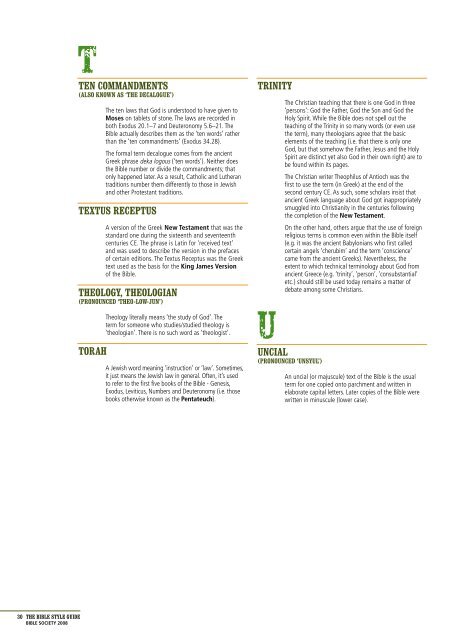BiBle STyle Guide - Get a Free Blog
BiBle STyle Guide - Get a Free Blog
BiBle STyle Guide - Get a Free Blog
You also want an ePaper? Increase the reach of your titles
YUMPU automatically turns print PDFs into web optimized ePapers that Google loves.
30 The <strong>BiBle</strong> <strong>STyle</strong> <strong>Guide</strong><br />
bible society 2008<br />
t<br />
ten commandments<br />
(also known as ‘the decalogUe’)<br />
The ten laws that God is understood to have given to<br />
Moses on tablets of stone. The laws are recorded in<br />
both Exodus 20.1–7 and Deuteronomy 5.6–21. The<br />
Bible actually describes them as the ‘ten words’ rather<br />
than the ‘ten commandments’ (Exodus 34.28).<br />
The formal term decalogue comes from the ancient<br />
Greek phrase deka logous (‘ten words’). Neither does<br />
the Bible number or divide the commandments; that<br />
only happened later. As a result, Catholic and Lutheran<br />
traditions number them differently to those in Jewish<br />
and other Protestant traditions.<br />
textUs receptUs<br />
A version of the Greek New testament that was the<br />
standard one during the sixteenth and seventeenth<br />
centuries CE. The phrase is Latin for ‘received text’<br />
and was used to describe the version in the prefaces<br />
of certain editions. The Textus Receptus was the Greek<br />
text used as the basis for the King James Version<br />
of the Bible.<br />
theology, theologian<br />
(pronoUnced ‘theo-low-JUn’)<br />
torah<br />
Theology literally means ‘the study of God’. The<br />
term for someone who studies/studied theology is<br />
‘theologian’. There is no such word as ‘theologist’.<br />
A Jewish word meaning ‘instruction’ or ‘law’. Sometimes,<br />
it just means the Jewish law in general. Often, it’s used<br />
to refer to the first five books of the Bible - Genesis,<br />
Exodus, Leviticus, Numbers and Deuteronomy (i.e. those<br />
books otherwise known as the Pentateuch).<br />
trinity<br />
The Christian teaching that there is one God in three<br />
‘persons’: God the Father, God the Son and God the<br />
Holy Spirit. While the Bible does not spell out the<br />
teaching of the Trinity in so many words (or even use<br />
the term), many theologians agree that the basic<br />
elements of the teaching (i.e. that there is only one<br />
God, but that somehow the Father, Jesus and the Holy<br />
Spirit are distinct yet also God in their own right) are to<br />
be found within its pages.<br />
The Christian writer Theophilus of Antioch was the<br />
first to use the term (in Greek) at the end of the<br />
second century CE. As such, some scholars insist that<br />
ancient Greek language about God got inappropriately<br />
smuggled into Christianity in the centuries following<br />
the completion of the New testament.<br />
On the other hand, others argue that the use of foreign<br />
religious terms is common even within the Bible itself<br />
(e.g. it was the ancient Babylonians who first called<br />
certain angels ‘cherubim’ and the term ‘conscience’<br />
came from the ancient Greeks). Nevertheless, the<br />
extent to which technical terminology about God from<br />
ancient Greece (e.g. ‘trinity’, ‘person’, ‘consubstantial’<br />
etc.) should still be used today remains a matter of<br />
debate among some Christians.<br />
U<br />
Uncial<br />
(pronoUnced ‘UnsyUl’)<br />
An uncial (or majuscule) text of the Bible is the usual<br />
term for one copied onto parchment and written in<br />
elaborate capital letters. Later copies of the Bible were<br />
written in minuscule (lower case).


